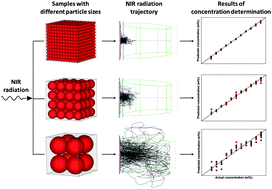Investigation of the particle size-dependent near-infrared spectral features of binary mixture samples in conjunction with Monte Carlo simulation and the influence of particle size on the accuracy of quantitative analysis†
Abstract
Near-infrared (NIR) spectral features of a target component can be influenced by its particle size as well as the particle sizes of the surrounding components in multi-component samples; therefore, understanding the essence of particle size-induced spectral variation is fundamental for robust quantitative analysis. For systematic investigation, two different types of binary-component samples were prepared. First, in ambroxol/lactose powders, only the particle size of lactose (surrounding filler) was varied, while the particle size of ambroxol (a target component) remained unchanged. Second, in lactose/PE pellets, the particle size of lactose (a target component) was only varied. When measuring ambroxol/lactose powders, the absorbances of both ambroxol and lactose peaks were elevated as the particle size of lactose increased. The larger lactose particle made the photon propagation broader in the sample, so a greater amount of ambroxol was able to interact with NIR photons; this led to an increase in absorbance. In the case of lactose (10 wt%)/PE pellets, the absorbance of lactose oppositely decreased as the lactose particle size increased. Since PE was the dominant component (85–95%) and had a small particle size (7 μm), the depth of photon propagation was substantially shallow. In this situation, the larger lactose particles would sometimes not be located within the small sampling volume and/or the photons would only partially interact with the particles; this led to a decrease in the absorbance. For both binary samples, the accuracies for the determination of target concentrations deteriorated as the particle size increased. This was due to the degradation of the measurement reproducibility caused by the increased uncertainty in the photon propagation. Monte Carlo simulation was effective for probing the photon propagation inside samples and supportive to explain the experimental observations.



 Please wait while we load your content...
Please wait while we load your content...